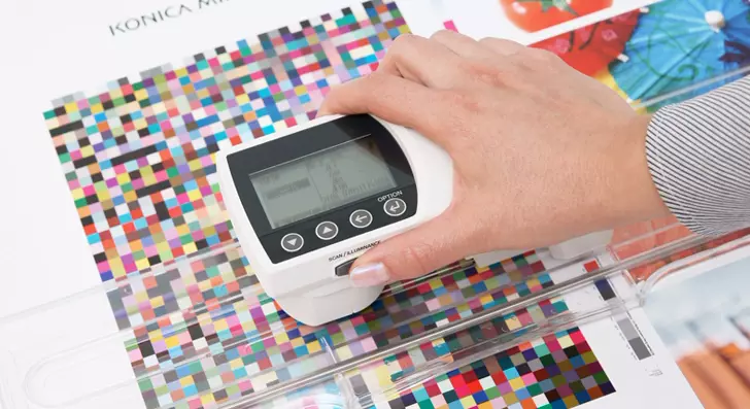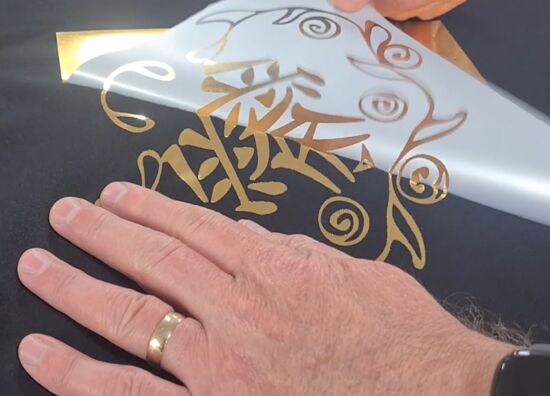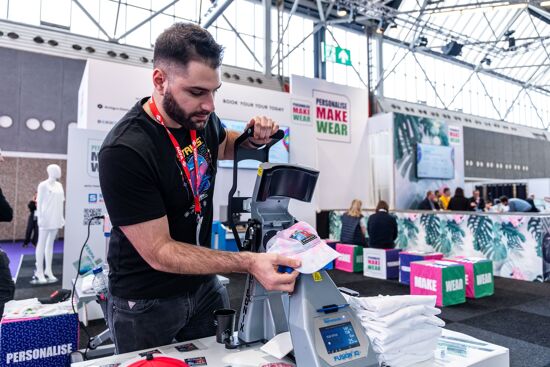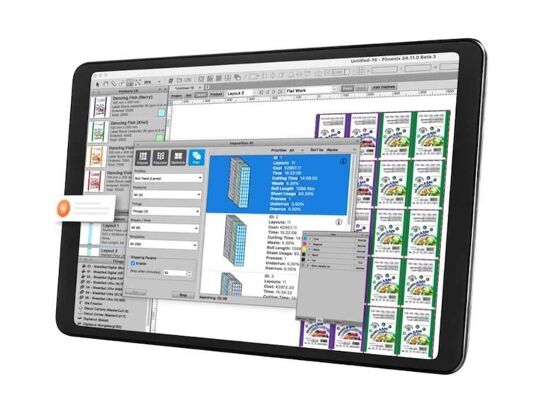The latest in colour measuring devices

Paul Sherfield provides a new update on the newest colour measuring devices on the market.
All the devices below are designed to work to the latest graphic arts standards and specifications; D50, M), M1 and M2 measurements to conform to ISO13655-2017. Below are a list of smaller less expensive smart phone attached spectrophotometers. To determine the best and correct spectrophotometer for your business please refer to this article.
Tethered handheld spectrophotometers
These devices need to be connected to a computer and the associated software, as they work as a measurement device with no ‘on-board’ software.
X-Rite have dominated this area for many years with their iOnePro spectrophotometers, the latest being the iOnePro 3 series. This includes the iOnePro 3 Plus with a larger measuring aperture, 8mm, which X- Rite say makes it suitable for “highly textured paper, fabric, canvas, ceramic, and transparent materials”. This is predominantly targeted at the wide format sector.
As well using its own X-Rite software, it is also supported by a wide range of 3rd party colour management developers and digital front ends, such as Fiery, ColorLogic, Alwan, Caldera, Print Factory and many others.

In 2018, Konica Minolta launched the Myiro 1 in direct competition to the iOnePro from X-Rite. Its basic software package, Myrio Tools, is a little more comprehensive then the iOnePro Basic, including a colour profiling solution. It is now also supported by many 3rd party colour management solution and digital front end vendors. Myrio is now a separate ‘brand’ within the Konica Minolta family.

Independent handhelp spectrophotometers
These spectrophotometers all have software and measurement functions bult into the spectrophotometer so can be used without the need to be connected to a computer. They can also connect to other software on a computer via USB or Wi-Fi. X-Rite have the latest eXact 2, available in 3 models, see this link for details:

Techkon have the SpectroDens, which offers very similar functions to the X-Rite eXact models. It is available in three models, Basic, Advanced and Premium, see link below for details:
Konica Minolta has two spectrophotometers available in this area, the FD5 and the FD7 which look very similar, with the FD9 offering more advanced options.

Barbieri have a different approach to this area with their Spectropad DOC
.jpg?lang=en-GB)
Scanning spectrophotometers
These devices automate and speed up the area of scanning colour patches for producing ICC colour profiles. They are the relatively expense when compared to the spectrophotometers above in this article.
X-Rite have their i1iSis 2 scanning spectrophotometer, Konica Minolta have the Myrio 9, (formally called the KM FD9).


Barbieri must be featured here as they are firmly focused on the wild format and textile areas. They have their Spectro LFP qb and Spectro LFP qb textile edition device. These have the added advantage of a reading head that can be detached and used as a handheld device. They also have the Spectro Swing scanning spectrophotometer which serves a similar purpose as the X-Rite and Konica Minolta scanning devices.


In addition, X-Rite have the i1iO table which automates the scanning function of an iOne Pro 3 spectrophotometer.

Konica Minolta have a similar device which automates their FD 5 and 7 devices called ColorScout A3+

RICOH Auto Color Adjustor

This new and the first colour management device from Ricoh is possibly the fastest spectrophotometer on the market, Ricoh state:
“The RICOH Auto Color Adjuster combines Ricoh's advanced optical and digital technologies to adjust colors automatically. Simply place the printed chart in the tray and Ricoh spectral color imagery technology quickly scans the entire chart. An ICC profile is automatically generated, and colors are efficiently adjusted for multiple printers.”
This is an interesting and high-end device which is designed to connect to several digital printing devices, offering process control validation, automated device profile creation and loading to the correct print queue and matching a previous printed copy by creating a simulation profile by scanning the printed copy.
At present it connects the cut sheet toner digital presses via a Fiery digital front end but one would surmise in the future, it would be available to other digital presses and DFE’s including the wide format area, where it would be very effect in creating device profiles for a fleet of wide format inkjet presses.
It is currently available in Europe, Japan and the USA.
Small, cheap devices using smart phones
As stated in the previous piece on this area, there have been several small, very inexpensive, spectrophotometers released over the past couple years that work via smart phone apps. They will measure colours and give an CIE Lab reading of some form.
It would seem that many are aimed at the prosumer photographer and retail colour markets such as paints and cosmetics, rather than the high-end graphic arts areas. To discover how Fogra are evaluating these type of devices read this article.
3 can be seen below including ColorReader from Data colour, Spectro 1 Pro and Nix Color Sensor.
.jpg?lang=en-GB)
The question is, are these types of instruments suitable for use in the graphic arts areas?
Issues To Consider
The number of issues to consider remain as before:
- Are they a ‘real’ spectrophotometer, or a colorimeter with limited functions?
- Do they measure in the D50, 2 degrees modes needed for graphic arts?
- The need for M0, M1, M2 and M3 measurements
- What is their repeatably over reading and time?
- What is the inter-instrument agreement with other devices in use?
- Can they be recalibrated?
- How/if can they be integrated with other systems and software’s?
It is often difficult to find any of this information from the device’s web sites. Variable have stated that their ‘top end’ Spectro 1 Pro does not conform to M1 reading specifications.
Nix have confirmed that the Nix Spectro does conform to the M0, M1 etc specifications, It also does integrate with some graphic arts colour management and process control software’s.The latest in colour measuring devices
Paul Sherfield provides a new update on the newest colour measuring devices on the market.
All the devices below are designed to work to the latest graphic arts standards and specifications; D50, M), M1 and M2 measurements to conform to ISO13655-2017. Below are a list of smaller less expensive smart phone attached spectrophotometers. To determine the best and correct spectrophotometer for your business please refer to this article
Topics
Interested in joining our community?
Enquire today about joining your local FESPA Association or FESPA Direct
Recent news

Special Effects in DTF Will Make Your “Prints” More Memorable
The DTF market is expanding with new vendors and innovations like multi-head printers enabling diverse ink options (spot, neon). Decorative films offer streamlined special effects. Keypoint Intelligence tested metallic and glitter films, noting varied ease of use and wash durability. New technology using adhesive and foil directly promises further creative advancements in DTF.

SmartHub – Expectations, opportunities and why you should attend!
The SmartHub at Personalisation Experience 2025 in Berlin will showcase personalisation and smart production opportunities across industries like textiles. Featuring a Smart Factory Trail with brands like Inkcups and Trotec, and a conference with experts discussing AI, mass customisation, and profit strategies, it offers insights into reducing waste and boosting efficiency through digital methods. Panel sessions will explore growth, automation in textiles, and smart manufacturing.

How is AI revolutionising Large Format Print?
Nessan Clearly discusses how AI in print relies on data pattern matching, already enhancing software for large format providers. He predicts that this will result in increased AI integration in workflow planning, job queue management, colour correction, image upscaling, and predictive maintenance via sensors and vision systems, ultimately streamlining operations and offering greater flexibility.
.png?width=550)
Why are FESPA events the ideal place for visionaries to meet? With Harold Klaren from EFKA
We speak to Harold Klaren, International Sales Manager at EFKA about visionaries in print. Harold shares why he believes FESPA events are the ideal place for visionareis to meet.